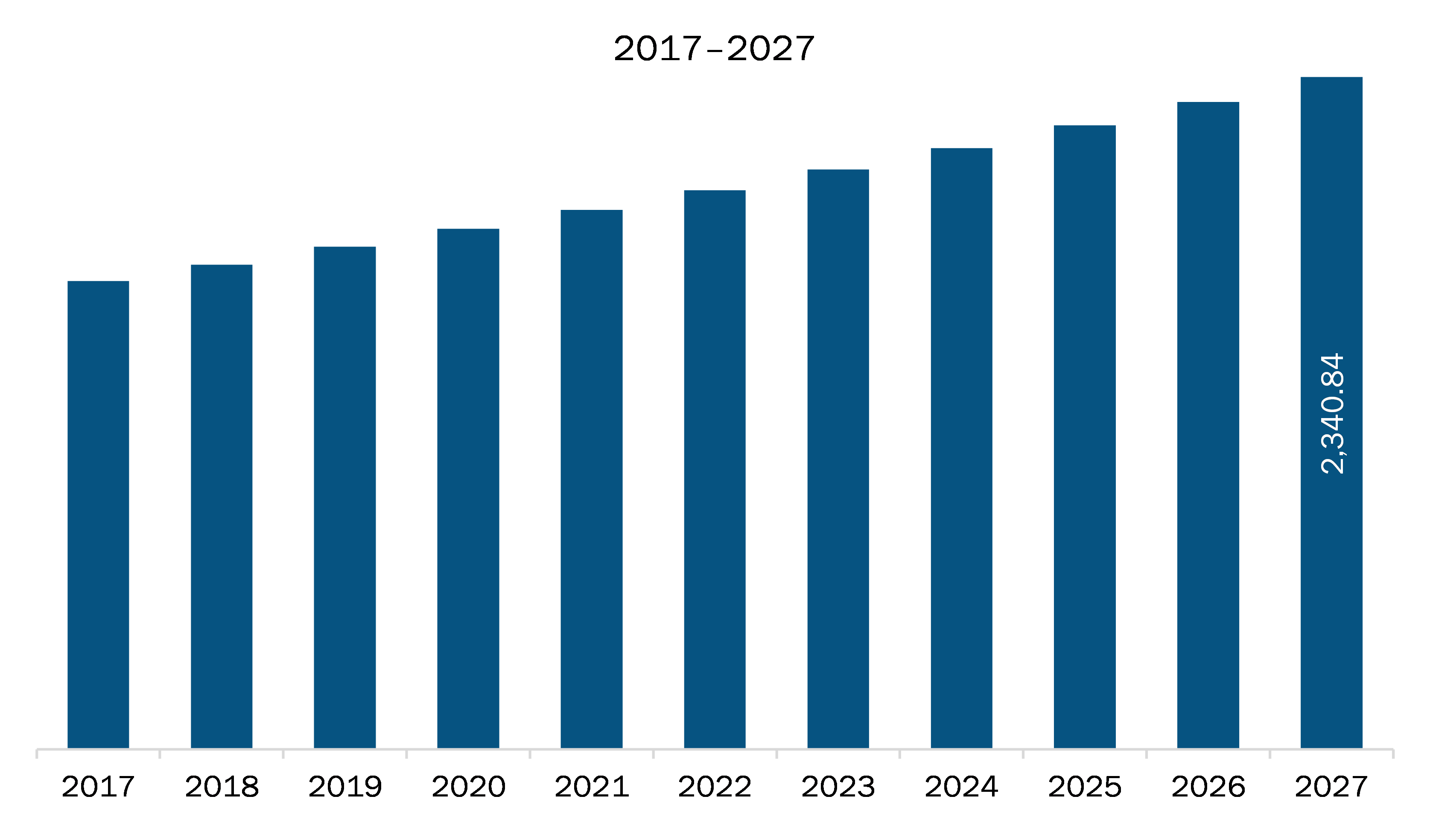The Europe glass fiber market is expected to grow from US$ 1,812.40 million in 2020 to US$ 2,340.84 million by 2027; it is estimated to grow at a CAGR of 3.7% from 2020 to 2027.
The UK, Germany, France, and Italy are major economies in Europe. Increasing demand of fiberglass composites from the automotive industry is expected to escalate the market growth. The automotive industry uses number of materials such as iron, aluminum, plastic, steel, and glass to build cars and other vehicles. Fiberglass composite is extensively used as a substitute for aluminum and steel due to its lightweight, high tensile strength, and superior corrosion resistance. All these properties of fiberglass composite are important in automobile manufacturing. Fiberglass composites are utilized in the production of several vehicle parts, especially of sports cars, where weight is crucial. They are mainly used in front and rear bumpers, doors, hoods, and casings. They are also used in the timing belts and V-belts, where glass strings are impregnated with rubber as reinforcement. Fiberglass is also used in vehicle tire reinforcement. Fiberglass reinforced tire provides a greater resistance to damage, better stability, lower reinforcement cost, and a good overall performance in long distance driving. This material is also used in brake pads and clutches, owing to its high abrasion resistance. Fiberglass composites are utilized in the manufacturing of parts for trains and trams. Almost the entire outer body of some modern trains and buses is made of fiberglass composites. They are also used utilized in creation of interior parts. Higher strength-to-weight ratio and great fire resistance properties have made them suitable for high-speed applications. In addition, stringent regulations have been imposed on the automotive industry to reduce carbon dioxide emissions. This has encouraged the industry to introduce fuel-efficient lightweight vehicles to help reduce greenhouse gas emissions. Vehicles built using fiberglass composites deliver higher mileage and enhance fuel efficiency. Thus, the rising demand for lightweight materials, along with government initiatives to reduce the harmful gas emissions and increase fuel efficiency, is expected to drive the Europe glass fiber market in automotive applications.
In case of COVID-19, Europe is highly Affected Specially Russia which has recorded the highest number of COVID cases. Other than this, France, UK, Italy, Spain and Germany have also been hit hard and are expected to suffer an economic hit due to a lack of revenue from various industries. Other member states have implemented drastic measures and travel restrictions, including partially closing their borders. This is anticipated to impact market growth in Europe. The COVID-19 has been affecting economies and industries in various countries due to lockdowns, travel bans, and business shutdowns. The European chemical and materials industry is one of the major industries that is suffering serious disruptions such as supply chain breaks, technology events cancellations, office shutdowns etc. because of this outbreak.
With the new features and technologies, vendors can attract new customers and expand their footprints in emerging markets. This factor is likely to drive the Europe glass fiber market. The Europe glass fiber market is expected to grow at a good CAGR during the forecast period.

- This FREE sample will include data analysis, ranging from market trends to estimates and forecasts.
Europe Glass Fiber Market Segmentation
Europe Glass Fiber Market – By Fiber Type
- E/ECR-Glass Fiber
- S-Glass Fiber
- C-Glass Fiber
- Others
Europe Glass Fiber Market – By Product Type
- Single-End Roving
- Multi-End Roving
- Woven Roving
- Others
Europe Glass Fiber Market – By Application
- Marine
- Transportation
- Aerospace
- Construction
- Electrical and Electronics
- Consumer Goods
- Others
Europe Glass Fiber Market – By Manufacturing Process
- Hand Lay Up
- Spray Up
- Prepreg Lay Up
- Injection Molding
- Compression Molding
- Resin Infusion
- Others
Europe Glass Fiber Market, by Country
- Germany
- France
- Italy
- UK
- Rest of Europe
Europe Glass Fiber Market -Companies Mentioned
- China Jushi Co., Ltd.
- Chongqing Polycomp International Corp. (CPIC)
- Johns Manville
- Nippon Electric Glass Co.,Ltd.
- Owens Corning
- SAINT GOBAIN S.A.
- Taishan Fiberglass Inc. (CTG)
Europe Glass Fiber Report Scope
| Report Attribute | Details |
|---|---|
| Market size in 2020 | US$ 1,812.40 Million |
| Market Size by 2027 | US$ 2,340.84 Million |
| CAGR (2020 - 2027) | 3.7% |
| Historical Data | 2018-2019 |
| Forecast period | 2021-2027 |
| Segments Covered |
By Fiber Type
|
| Regions and Countries Covered |
Europe
|
| Market leaders and key company profiles |
|
- Historical Analysis (2 Years), Base Year, Forecast (7 Years) with CAGR
- PEST and SWOT Analysis
- Market Size Value / Volume - Regional, Country
- Industry and Competitive Landscape
- Excel Dataset
Recent Reports
Testimonials
Reason to Buy
- Informed Decision-Making
- Understanding Market Dynamics
- Competitive Analysis
- Identifying Emerging Markets
- Customer Insights
- Market Forecasts
- Risk Mitigation
- Boosting Operational Efficiency
- Strategic Planning
- Investment Justification
- Tracking Industry Innovations
- Aligning with Regulatory Trends






















 Get Free Sample For
Get Free Sample For